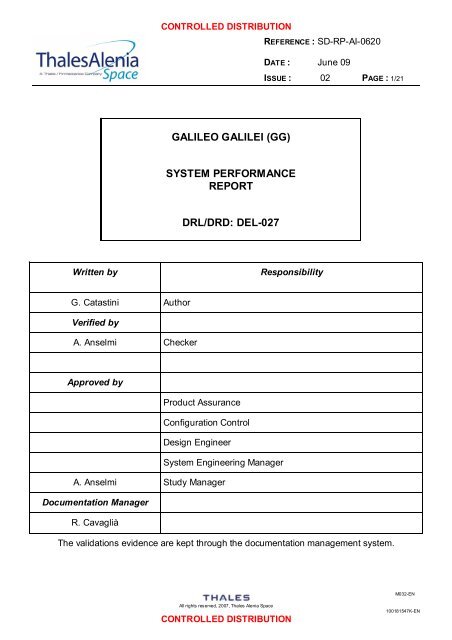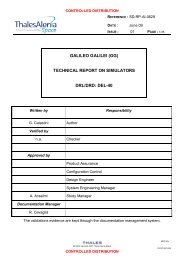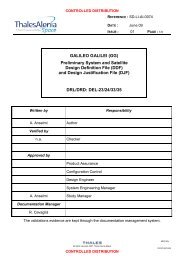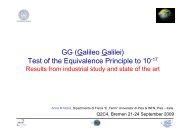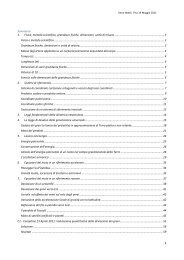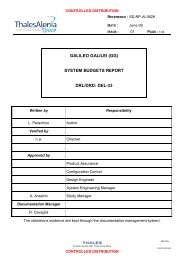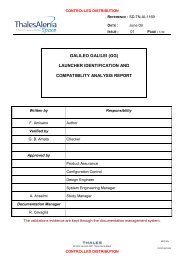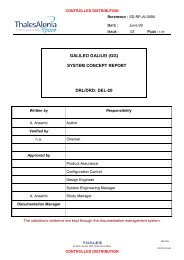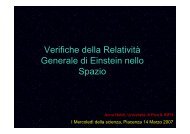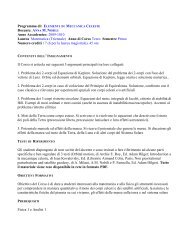SD-RP-AI-0620_2 GG Performance.pdf - âGalileo Galileiâ (GG
SD-RP-AI-0620_2 GG Performance.pdf - âGalileo Galileiâ (GG
SD-RP-AI-0620_2 GG Performance.pdf - âGalileo Galileiâ (GG
Create successful ePaper yourself
Turn your PDF publications into a flip-book with our unique Google optimized e-Paper software.
CONTROLLED DISTRIBUTIONREFERENCE :<strong>SD</strong>-<strong>RP</strong>-<strong>AI</strong>-<strong>0620</strong>DATE :June 09ISSUE : 02 PAGE : 1/21GALILEO GALILEI (<strong>GG</strong>)SYSTEM PERFORMANCEREPORTDRL/DRD: DEL-027Written byResponsibilityG. Catastini AuthorVerified byA. Anselmi CheckerApproved byProduct AssuranceConfiguration ControlDesign EngineerSystem Engineering ManagerA. Anselmi Study ManagerDocumentation ManagerR. CavagliàThe validations evidence are kept through the documentation management system.M032-ENAll rights reserved, 2007, Thales Alenia SpaceCONTROLLED DISTRIBUTION100181547K-EN
CONTROLLED DISTRIBUTIONREFERENCE :<strong>SD</strong>-<strong>RP</strong>-<strong>AI</strong>-<strong>0620</strong>DATE :June 09ISSUE : 02 PAGE : 2/21ISSUE DATE § CHANGE RECORDS AUTHORDraft1.003-03-09 First draft produced for IRR, circulated for comments GC1 12-03-09 IRR issue2 08-Jun-09 Issue submitted to PRRM032-ENAll rights reserved, 2007, Thales Alenia SpaceCONTROLLED DISTRIBUTION100181547K-EN
CONTROLLED DISTRIBUTIONREFERENCE :<strong>SD</strong>-<strong>RP</strong>-<strong>AI</strong>-<strong>0620</strong>DATE :June 09ISSUE : 02 PAGE : 3/21TABLE OF CONTENTS1. SCOPE AND PU<strong>RP</strong>OSE ..................................................................................................52. REFERENCES .................................................................................................................62.1 Applicable Documents ................................................................................................................... 62.2 Standards ....................................................................................................................................... 62.3 ASI Reference Documents.............................................................................................................. 62.4 <strong>GG</strong> Phase A2 Study Notes .............................................................................................................. 63. <strong>GG</strong> EXPERIMENT ERROR BUDGET ...............................................................................83.1 Error Budget Formulation............................................................................................................... 83.2 Experiment Environment ................................................................................................................ 93.3 Error Budget................................................................................................................................. 17M032-ENAll rights reserved, 2007, Thales Alenia SpaceCONTROLLED DISTRIBUTION100181547K-EN
CONTROLLED DISTRIBUTIONREFERENCE :<strong>SD</strong>-<strong>RP</strong>-<strong>AI</strong>-<strong>0620</strong>DATE :June 09ISSUE : 02 PAGE : 4/21LIST OF FIGURESFIGURE 3.2-1: NON-GRAVITATIONAL ACCELERATION IN THE IRF [X AXIS] .....................................................................................9FIGURE 3.2-2: NON-GRAVITATIONAL ACCELERATION IN THE IRF [Y AXIS] ...................................................................................10FIGURE 3.2-3: NON-GRAVITATIONAL ACCELERATION IN THE LHLV REFERENCE FRAME [X AXIS]................................................11FIGURE 3.2-4: NON-GRAVITATIONAL ACCELERATION IN THE LHLV REFERENCE FRAME [Y AXIS]................................................12FIGURE 3.2-5: NON-GRAVITATIONAL ACCELERATION IN THE LHLV REFERENCE FRAME [Z AXIS] ................................................13FIGURE 3.2-6: NON-GRAVITATIONAL ACCELERATION IN THE LHLV REFERENCE FRAME AFTER DFAC AND DIFFERENTIALACCELEROMETER COMMON MODE REJECTION [X AXIS] .......................................................................................................14FIGURE 3.2-7: NON-GRAVITATIONAL ACCELERATION IN THE LHLV REFERENCE FRAME AFTER DFAC AND DIFFERENTIALACCELEROMETER COMMON MODE REJECTION [Y AXIS] .......................................................................................................15FIGURE 3.2-8: NON-GRAVITATIONAL ACCELERATION IN THE LHLV REFERENCE FRAME AFTER DFAC AND DIFFERENTIALACCELEROMETER COMMON MODE REJECTION [Z AXIS]........................................................................................................16FIGURE 3.3-1: AMPLITUDE SPECTRUM OF THE TEST MASSES DIFFERENTIAL DISPLACEMENT DUE TO THE M<strong>AI</strong>N SYSTEMATICERRORS VS. THE TARGET EP VIOLATION SIGNAL...................................................................................................................18FIGURE 3.3-2: DET<strong>AI</strong>LED VIEW OF THE AMPLITUDE SPECTRUM OF THE M<strong>AI</strong>N SYSTEMATIC ERRORS..............................................19FIGURE 3.3-3: MAGNITUDE OF THE ERRORS WITH THE SAME FREQUENCY SIGNATURE AS THE EP VIOLATION SIGNAL, ASFUNCTION OF INTEGRATION TIME..........................................................................................................................................20M032-ENAll rights reserved, 2007, Thales Alenia SpaceCONTROLLED DISTRIBUTION100181547K-EN
CONTROLLED DISTRIBUTIONREFERENCE :<strong>SD</strong>-<strong>RP</strong>-<strong>AI</strong>-<strong>0620</strong>DATE :June 09ISSUE : 02 PAGE : 5/211. SCOPE AND PU<strong>RP</strong>OSEThis document is submitted in partial fulfilment of Work Package 1A-ADA of the <strong>GG</strong> Phase A2Study. It provides the analysis of the <strong>GG</strong> system performance. For an experiment such as <strong>GG</strong>,the performance is synthesised by an error budget of the scientific measurement. The documentprovides the experiment error budget and the associated justification.M032-ENAll rights reserved, 2007, Thales Alenia SpaceCONTROLLED DISTRIBUTION100181547K-EN
CONTROLLED DISTRIBUTIONREFERENCE :<strong>SD</strong>-<strong>RP</strong>-<strong>AI</strong>-<strong>0620</strong>DATE :June 09ISSUE : 02 PAGE : 6/212. REFERENCES2.1 Applicable Documents[AD 1] ASI, “Progetto Galileo Galilei-<strong>GG</strong> Fase A-2, Capitolato Tecnico”, DC-IPC-2007-082, Rev. B,10-10-2007 and applicable documents defined therein2.2 Standards[<strong>SD</strong> 1] ECSS-M-00-02A, Space Project Management – Tailoring of Space Standards, 25 April 2000[<strong>SD</strong> 2] ECSS-E-ST-10C, Space Engineering - System Engineering General Requirements, 6 March2009[<strong>SD</strong> 3] ECSS-E-10-02A, Space Engineering – Verification[<strong>SD</strong> 4] ECSS-Q-00A, Space Product Assurance - Policy and Principles, and related Level 2standards.2.3 ASI Reference Documents[RD 1] <strong>GG</strong> Phase A Study Report, Nov. 1998, revised Jan. 2000, available at:http://eotvos.dm.unipi.it/nobili/ggweb/phaseA/index.html[RD 2] Supplement to <strong>GG</strong> Phase A Study (<strong>GG</strong> in sun-synchronous Orbit) “Galileo Galilei-<strong>GG</strong>”: design,requirements, error budget and significance of the ground prototype”, A.M. Nobili et al.,Physics Letters A 318 (2003) 172–183, available at:http://eotvos.dm.unipi.it/nobili/documents/generalpapers/<strong>GG</strong>_PLA2003.<strong>pdf</strong>[RD 3] A. Nobili, DEL001: <strong>GG</strong> Science Requirements, Pisa, September 20082.4 <strong>GG</strong> Phase A2 Study Notes[RD 4] <strong>SD</strong>-<strong>RP</strong>-<strong>AI</strong>-0625, <strong>GG</strong> Final Report / Satellite Detailed Architecture Report, Issue 1[RD 5] <strong>SD</strong>-<strong>RP</strong>-<strong>AI</strong>-0626, <strong>GG</strong> Phase A2 Study Executive Summary, Issue 1[RD 6] <strong>SD</strong>-TN-<strong>AI</strong>-1163, <strong>GG</strong> Experiment Concept and Requirements Document, Issue 3[RD 7] <strong>SD</strong>-<strong>RP</strong>-<strong>AI</strong>-<strong>0620</strong>, <strong>GG</strong> System <strong>Performance</strong> Report, Issue 2[RD 8] <strong>SD</strong>-TN-<strong>AI</strong>-1167, <strong>GG</strong> Mission Requirements Document, Issue 2[RD 9] <strong>SD</strong>-<strong>RP</strong>-<strong>AI</strong>-0590, <strong>GG</strong> System Concept Report (Mission Description Document), Issue 3[RD 10] <strong>SD</strong>-SY-<strong>AI</strong>-0014, <strong>GG</strong> System Functional Specification and Preliminary System TechnicalSpecification, Issue 1[RD 11] <strong>SD</strong>-<strong>RP</strong>-<strong>AI</strong>-0631, <strong>GG</strong> Consolidated Mission Description Document, Issue 1[RD 12] <strong>SD</strong>-TN-<strong>AI</strong>-1168, <strong>GG</strong> Mission Analysis Report, Issue 2[RD 13] DTM, <strong>GG</strong> Structure Design and Analysis Report , Issue 1M032-ENAll rights reserved, 2007, Thales Alenia SpaceCONTROLLED DISTRIBUTION100181547K-EN
CONTROLLED DISTRIBUTIONREFERENCE :<strong>SD</strong>-<strong>RP</strong>-<strong>AI</strong>-<strong>0620</strong>DATE :June 09ISSUE : 02 PAGE : 7/21[RD 14] <strong>SD</strong>-<strong>RP</strong>-<strong>AI</strong>-0627, <strong>GG</strong> Thermal Design and Analysis Report, Issue 1[RD 15] <strong>SD</strong>-<strong>RP</strong>-<strong>AI</strong>-0268, <strong>GG</strong> System Budgets Report, Issue 1[RD 16] <strong>SD</strong>-<strong>RP</strong>-<strong>AI</strong>-0621, Technical Report on Drag and Attitude Control, Issue 2[RD 17] TL25033, Payload Architectures and Trade-Off Report, Issue 3[RD 18] <strong>SD</strong>-<strong>RP</strong>-<strong>AI</strong>-0629, Technical Report on Simulators, Issue 1[RD 19] ALTA, FEEP Thruster Design and Accommodation Report, Issue 1[RD 20] TASI-FI-44/09, Cold Gas Micro Thruster System for Galileo Galilei (<strong>GG</strong>) Spacecraft - TechnicalReport, Issue 1, May 2009[RD 21] <strong>SD</strong>-<strong>RP</strong>-<strong>AI</strong>-0630, Spin Sensor Design, Development and Test Report, Issue 1[RD 22] <strong>SD</strong>-TN-<strong>AI</strong>-1169, <strong>GG</strong> Launcher Identification and Compatibility Analysis Report, Issue 1[RD 23] ALTEC-AD-001, <strong>GG</strong> Ground Segment Architecture and Design Report, Issue 1[RD 24] <strong>SD</strong>-TN-<strong>AI</strong>-1218, <strong>GG</strong> Preliminary Product Tree, Issue 1[RD 25] <strong>SD</strong>-PL-<strong>AI</strong>-0227, <strong>GG</strong> System Engineering Plan (SEP), Issue 2[RD 26] TAS-I, Payload Development and Verification Plan, Issue 1[RD 27] <strong>SD</strong>-PL-<strong>AI</strong>-0228, <strong>GG</strong> System Verification and Validation Plan, Issue 1[RD 28] <strong>SD</strong>-TN-<strong>AI</strong>-1219, Report on Frequency Management Issues, Issue 1[RD 29] <strong>SD</strong>-<strong>RP</strong>-<strong>AI</strong>-0632, <strong>GG</strong> Mission Risk Assessment And Mitigation Strategies Report, Issue 1[RD 30] <strong>SD</strong>-<strong>RP</strong>-<strong>AI</strong>-0633, Report on Mission Costs Estimates, Issue 1M032-ENAll rights reserved, 2007, Thales Alenia SpaceCONTROLLED DISTRIBUTION100181547K-EN
CONTROLLED DISTRIBUTIONREFERENCE :<strong>SD</strong>-<strong>RP</strong>-<strong>AI</strong>-<strong>0620</strong>DATE :June 09ISSUE : 02 PAGE : 8/213. <strong>GG</strong> EXPERIMENT ERROR BUDGET3.1 Error Budget FormulationThe mission goal of <strong>GG</strong> is testing the Equivalence Principle to 1 part in 10 17 . In order to achievethe goal, numerous competing effects, which have nothing to do with a possible violation of theEP, must be kept by design below the stated experiment sensitivity. The analysis of theseeffects is reported in [RD 6], as organized in terms of seven experiment “drivers”:1. the signal2. external non gravitational forces3. whirl motions4. gravitational forces (earth tides)5. satellite spin frequency6. electro-magnetic coupling and other disturbing effects7. temperatureEach driver, in turn, leads to derived requirements. The current definition of the requirementsset is in [RD 6].To prove that the stated requirement set is complete and sufficient, the <strong>GG</strong> simulator tool hasbeen set up [RD 18]. The simulator provides a full simulation of the <strong>GG</strong> experiment, including arealistic description of the instrument, the spacecraft and the environmental effects, and all theirinteractions.The simulator provides as output a time history of the relative displacements of the testcylinders under all the modelled environmental effects, plus an assumed EP-violation signal, atthe orbit frequency ν EP = 1.7538 × 10 -4 Hz in the inertial reference frame (IRF), of 0.6 pmmagnitude (corresponding to the sensitivity of η = 10 -17 ). The purpose of the simulation is toshow that, with the proper choice of the design parameters (the requirements), a violation signalof 0.6 pm magnitude can be detected and distinguished from the competing effects.Chapter 3.2 below provides, in graphical form, a description of the external environmentalacceleration environment and the effects of its suppression by the instrument common moderejection and the spacecraft drag-free control.M032-ENAll rights reserved, 2007, Thales Alenia SpaceCONTROLLED DISTRIBUTION100181547K-EN
CONTROLLED DISTRIBUTIONREFERENCE :<strong>SD</strong>-<strong>RP</strong>-<strong>AI</strong>-<strong>0620</strong>DATE :June 09ISSUE : 02 PAGE : 9/213.2 Experiment EnvironmentThe Figure 3.2-1 and Figure 3.2-2 provide the overall non gravitational acceleration(environment disturbances and s/c-PGB suspension force) sensed from the satellite centre ofmass wrt. the inertial reference frame. The environmental forces are computed by using theMSIS ‘86 atmospheric model for the computation of the air density, temperature and chemicalcomposition along the satellite orbit. The F10 and F10.B indexes related to the Solar activityand the Geomagnetic indexes Ap and Kp are used to feed the MSIS model. The solar radiationpressure and Earth albedo are computed modeling the satellite surface as a set of one cylinderand two simple flat surfaces.The mean value of each acceleration component has been reported in the picture as a blackline at the frequency 2·10 -6 Hz. In the IRF, the main component of the acceleration is at the orbitfrequency, i.e. at the same frequency of the EP violation signal.Figure 3.2-1: Non-gravitational acceleration in the IRF [X axis]M032-ENAll rights reserved, 2007, Thales Alenia SpaceCONTROLLED DISTRIBUTION100181547K-EN
CONTROLLED DISTRIBUTIONREFERENCE :<strong>SD</strong>-<strong>RP</strong>-<strong>AI</strong>-<strong>0620</strong>DATE :June 09ISSUE : 02 PAGE : 10/21Figure 3.2-2: Non-gravitational acceleration in the IRF [Y axis]The Figure 3.2-3, Figure 3.2-4 and Figure 3.2-5 provide the same previous overall nongravitational acceleration (environment disturbances and s/c-PGB suspension force) sensedfrom the satellite centre of mass wrt. LVLH frame.The mean value of each acceleration component has been reported in the picture as a blackline at the frequency 2·10 -6 Hz. In the LVLH frame, the main component of the external nongravitational acceleration is the mean term along Y. The EP violation signal consists of a testmass differential acceleration (displacement) along X.M032-ENAll rights reserved, 2007, Thales Alenia SpaceCONTROLLED DISTRIBUTION100181547K-EN
CONTROLLED DISTRIBUTIONREFERENCE :<strong>SD</strong>-<strong>RP</strong>-<strong>AI</strong>-<strong>0620</strong>DATE :June 09ISSUE : 02 PAGE : 11/21Figure 3.2-3: Non-gravitational acceleration in the LHLV reference frame [X axis]M032-ENAll rights reserved, 2007, Thales Alenia SpaceCONTROLLED DISTRIBUTION100181547K-EN
CONTROLLED DISTRIBUTIONREFERENCE :<strong>SD</strong>-<strong>RP</strong>-<strong>AI</strong>-<strong>0620</strong>DATE :June 09ISSUE : 02 PAGE : 12/21Figure 3.2-4: Non-gravitational acceleration in the LHLV reference frame [Y axis]M032-ENAll rights reserved, 2007, Thales Alenia SpaceCONTROLLED DISTRIBUTION100181547K-EN
CONTROLLED DISTRIBUTIONREFERENCE :<strong>SD</strong>-<strong>RP</strong>-<strong>AI</strong>-<strong>0620</strong>DATE :June 09ISSUE : 02 PAGE : 13/21Figure 3.2-5: Non-gravitational acceleration in the LHLV reference frame [Z axis]The Figure 3.2-6, Figure 3.2-7and Figure 3.2-8 provide the same previous overall nongravitational acceleration (environment disturbances and s/c-PGB suspension force) sensedfrom the satellite centre of mass wrt. LVLH frame after the DFC compensation and themechanical suspension rejection (CMRR).The mean value (in the LVLH frame) of each acceleration component is not visible anymore,due to the DFC action and to the CMRR: mean(a X_LVLH ) = 4.9·10 -19 m/s 2 , mean(a Y_LVLH ) =1.8·10 -17 m/s 2 , mean(a Z_LVLH ) = 8.6·10 -14 m/s 2 .M032-ENAll rights reserved, 2007, Thales Alenia SpaceCONTROLLED DISTRIBUTION100181547K-EN
CONTROLLED DISTRIBUTIONREFERENCE :<strong>SD</strong>-<strong>RP</strong>-<strong>AI</strong>-<strong>0620</strong>DATE :June 09ISSUE : 02 PAGE : 14/21Figure 3.2-6: Non-gravitational acceleration in the LHLV reference frame after DFAC andDifferential Accelerometer common mode rejection [X axis]M032-ENAll rights reserved, 2007, Thales Alenia SpaceCONTROLLED DISTRIBUTION100181547K-EN
CONTROLLED DISTRIBUTIONREFERENCE :<strong>SD</strong>-<strong>RP</strong>-<strong>AI</strong>-<strong>0620</strong>DATE :June 09ISSUE : 02 PAGE : 15/21Figure 3.2-7: Non-gravitational acceleration in the LHLV reference frame after DFAC andDifferential Accelerometer common mode rejection [Y axis]M032-ENAll rights reserved, 2007, Thales Alenia SpaceCONTROLLED DISTRIBUTION100181547K-EN
CONTROLLED DISTRIBUTIONREFERENCE :<strong>SD</strong>-<strong>RP</strong>-<strong>AI</strong>-<strong>0620</strong>DATE :June 09ISSUE : 02 PAGE : 16/21Figure 3.2-8: Non-gravitational acceleration in the LHLV reference frame after DFAC andDifferential Accelerometer common mode rejection [Z axis]M032-ENAll rights reserved, 2007, Thales Alenia SpaceCONTROLLED DISTRIBUTION100181547K-EN
CONTROLLED DISTRIBUTIONREFERENCE :<strong>SD</strong>-<strong>RP</strong>-<strong>AI</strong>-<strong>0620</strong>DATE :June 09ISSUE : 02 PAGE : 17/213.3 Error BudgetThe figures that follow provide the error budget of the systematic errors in graphical form.Figure 3.3-1 shows the amplitude spectrum of the test masses differential displacement due tothe main systematic errors vs. the simulated 0.6 pm EP violation signal. The amplitude of theerror at the orbit frequency is smaller than the signal by a factor about 4. The closest error line isat twice the orbit frequency, with an amplitude one order of magnitude larger than the signal.This error can be easily distinguished from the signal during data processing, since the durationof each elementary experiment is about one week. The amplitude of the error at 4 times theorbit frequency is negligible. The error at the whirl frequency is easily removed during thesynchronous demodulation of the post-processing.Figure 3.3-2 shows a detailed view with all the main error terms. At twice the frequency of theEP signal, the errors due to magnetic coupling are negligible. At this frequency the maincomponent of the displacement is due to the relative displacement of the test masses along thedirection Z of the spin axis, which, through the gravity gradient, generates a displacement in themeasurement plane. The relative displacement along Z is due mainly to the radiometric effect(worst case assumption for the residual pressure inside the PGB is made, and a better value isexpected). Smaller contributions are due to the residual non-gravitational acceleration and tothe differential thermal radiation emitted by the proof masses. At 4ν EP , two different magneticdisplacements induced, of negligible magnitude. The whirl and the Earth tides coupled with whirlgenerate three lines at frequencies ν WHIRL and ν WHIRL ± 2ν EP . The three lines appear here as asingle line at ν WHIRL due to their negligible separation in the logarithmic frequency scale. All threelines do not affect the signal detection, due to their large separation in frequency w.r.t. the orbitfrequency.Random noise is also available from the simulator. In <strong>GG</strong> the large mass of test bodies (10 kg)and the long period of their natural differential oscillations help in reducing thermal noise.Moreover, in supercritical rotation the relevant losses take place at the high spin frequency, atwhich they are small (as demonstrated by the losses measured with the laboratory prototype).Figure 3.3-3 shows a theoretical calculation of the thermal noise to be expected as the ultimatelimitation.The effects of electric charging are not modelled in the simulator. To reduce electric chargingeffects to negligible magnitude, one relies on gold coating of all the conductive surfaces andpassive electric grounding of the test masses, as well as co-rotation of the test masses and thecapacitance transducers. Moreover, surface charge patches can be measured in the <strong>GG</strong>Glaboratory prototype, as it was recently shown.M032-ENAll rights reserved, 2007, Thales Alenia SpaceCONTROLLED DISTRIBUTION100181547K-EN
CONTROLLED DISTRIBUTIONREFERENCE :<strong>SD</strong>-<strong>RP</strong>-<strong>AI</strong>-<strong>0620</strong>DATE :June 09ISSUE : 02 PAGE : 18/21Figure 3.3-1: Amplitude Spectrum of the test masses differential displacement due to themain systematic errors vs. the target EP violation signal.The target EP signal ∆x EP = 0.61 pm at the orbit frequency ν EP = 1.7538 × 10 -4 Hz, w.r.t. the inertialreference frame IRF, is shown for comparison. The amplitude of the error at the orbit frequency issmaller than the signal by a factor about 4. The closest error line is at twice the orbit frequency,with an amplitude one order of magnitude bigger of the signal: this error can be easilydistinguished from the signal during data processing, since the duration of each elementaryexperiment is about one week (the provided minimum step in frequency is about one millionth ofHz). The amplitude of the error at 4 times the orbit frequency is negligible. The error at the whirlfrequency is easily removed during the synchronous demodulation of the post-processing.M032-ENAll rights reserved, 2007, Thales Alenia SpaceCONTROLLED DISTRIBUTION100181547K-EN
CONTROLLED DISTRIBUTIONREFERENCE :<strong>SD</strong>-<strong>RP</strong>-<strong>AI</strong>-<strong>0620</strong>DATE :June 09ISSUE : 02 PAGE : 19/21Figure 3.3-2: Detailed view of the Amplitude Spectrum of the main systematic errors.The target EP violation signal ∆x EP = 0.61 pm at the orbit frequency is reported for directcomparison. At 2ν EP the errors due to magnetic coupling are negligible. At this frequency themain component of the displacement is due to the test masses differential displacement alongthe spin axis which through the gravity gradient generates a displacement in the plane of thescience measurement. The differential displacement along z is due mainly to the radiometriceffect (worst case assumption for the residual pressure inside the PGB is made, and a bettervalue is expected). Smaller contributions are due to the residual s/c non-gravitationalacceleration and to the proof masses emitted radiation. At 4ν EP , the two different magneticinduced displacements are negligible. The whirl and the Earth tides coupled with whirl generatethree lines at frequencies ν whirl and ν whirl ± 2ν EP . The three lines appear here as a single line atwhirl ν due to their negligible separation in the logarithmic frequency scale. All three lines do notaffect the signal detection, due to their large separation in frequency w.r.t. the orbit frequency.M032-ENAll rights reserved, 2007, Thales Alenia SpaceCONTROLLED DISTRIBUTION100181547K-EN
CONTROLLED DISTRIBUTIONREFERENCE :<strong>SD</strong>-<strong>RP</strong>-<strong>AI</strong>-<strong>0620</strong>DATE :June 09ISSUE : 02 PAGE : 20/21Figure 3.3-3: Magnitude of the errors with the same frequency signature as the EPviolation signal, as function of integration time.M032-ENAll rights reserved, 2007, Thales Alenia SpaceCONTROLLED DISTRIBUTION100181547K-EN
CONTROLLED DISTRIBUTIONREFERENCE :<strong>SD</strong>-<strong>RP</strong>-<strong>AI</strong>-<strong>0620</strong>DATE :June 09END OF DOCUMENTISSUE : 02 PAGE : 21/21M032-ENAll rights reserved, 2007, Thales Alenia SpaceCONTROLLED DISTRIBUTION100181547K-EN


